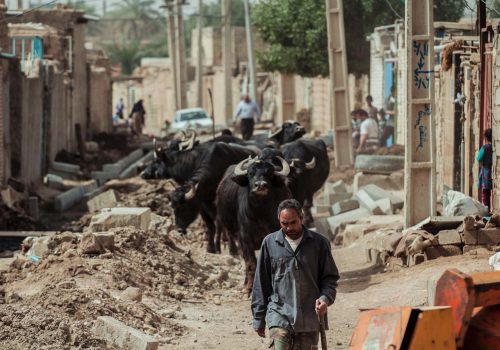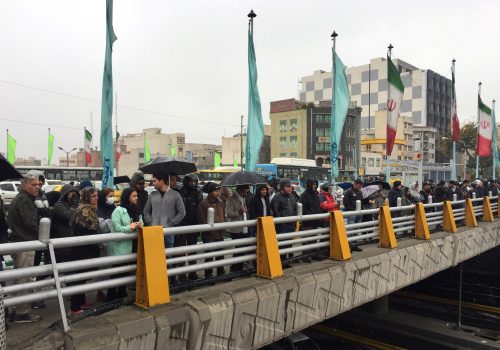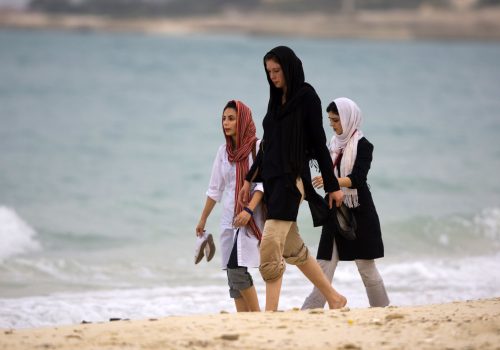Iran’s water is running dry. Now its water woes are worsening.
Iran faces an acute water crisis that has been the root of persisting and reoccurring nationwide protests and regional disputes. With the Islamic Republic disregarding the environmental and human costs of erratic development projects, coupled with the climate catastrophe that the world is facing, Iran has plunged headlong into a crisis with no safe shore in sight.
In November, thousands of Iranians flooded the dry bed of the Zayandeh Roud River in the central city of Isfahan, protesting what they saw as an unfair distribution of water.
Over the past four decades, numerous dams have been constructed in Iran to generate electricity and direct water to unsustainable industries. As rainfall levels plummeted in Iran (just like the broader Middle East and North Africa region), and with the state prioritizing industries and mines for water allocation, the farmers’ share of the shrinking resources dried up to a meager trickle.
Seeing their sole source of income at risk, Iranian farmers rallied in Isfahan and several other cities, with many joining the protest in solidarity.
The protests started around November 7 and went on for twenty days. People gathered under the watching eyes of security forces, with one group of farmers setting up tents on the dry riverbed of Zayandeh Roud, starting a sit-in.
Until November 25, gatherings were held with almost no impediments and even officials described farmers’ demands as “legitimate” and promised a “rapid response.” State media also grasped the opportunity to build a narrative around the Islamic Republic’s “tolerance” towards “legitimate protests”.
As part of its narrative-building effort, the state-run Islamic Republic of Iran Broadcasting aired footage of protests, mainly consisting of prerecorded interviews with handpicked farmers plus live videos of the gatherings. The live footage was mostly superimposed with nationalistic anthems to likely curb the risk of broadcasting anti-establishment chants of protesters, including people booing Supreme Leader Ayatollah Ali Khamenei. Around the same time, similar rallies were held in the southwestern Chaharmahal and Bakhtiari province. However, the gatherings did not get much media coverage.
On November 25, the Iranian state media reported that a deal had been forged between a farmers’ association and the state. As part of the deal, authorities demanded an end to the farmers’ sit-in. A group of farmers refused to bow down and, in response, the Islamic Republic unleashed brute force against peaceful protesters, who had been described as “honorable and noble” up until that point.
Late into the night of November 25, clad in riot gear, security forces raided the farmers’ camp, set fire to their tents, and brutally beat protesters.
The following day, Isfahan was again the scene of massive gatherings. To break up the protests, which spilled over well into November 27, security forces used birdshot, tear gas, water cannons, and batons. At the same time, mobile internet services were cut off and landline internet was throttled.
According to Iran Human Rights, more than three hundred people were arrested at the farmers’ peaceful protests, and around forty people lost at least one eye after being shot by security forces. Iranian officials have put the number of arrests at “around 130” and said most detainees have been released on bail.
At the same time, many Iranians took to Twitter and Instagram to show their solidarity with Isfahan protesters. Two hashtags, #اصفهان (Isfahan) and #اصفهان_تنها_نیست (Isfahan Isn’t Alone), were trending on Twitter for several days with people sharing videos and photos of the protests. When news emerged about the high number of Isfahan protesters suffering eye injuries at the hand of security forces, many posted photos of themselves covering one eye in solidarity.
Khuzestan protests
The Isfahan protests weren’t the only instance of civil unrest in Iran over water shortages in 2021.
One of the other provinces that has been the scene of widespread water protests is the oil-rich but impoverished southern Khuzestan province.
On November 25, amid calls for holding rallies similar to Isfahan, an almost total internet shutdown was imposed in Ahvaz, Khuzestan’s capital. The shutdown continued well into November 27 without any protests being held in the city.
This wasn’t the first time in 2021 that the Islamic Republic had resorted to cutting off the internet in Khuzestan to suppress water protests. In July, authorities cut off the internet and launched a bloody crackdown against peaceful water protests in the province.
Amnesty International has documented the human rights violations committed in the province by the Islamic Republic between July 16-21, where authorities resorted to unlawful use of force, including firing pellet rounds and live ammunition, killing at least eleven protesters and bystanders—a teenage boy among them—and injuring scores of others.
The scale of the deadly state violence in Khuzestan province, which is predominantly populated by Iran’s Arab ethnic minority, once again revealed that the Islamic Republic perceives minorities as second-class citizens. For decades, ethnic minorities have been subjected to systematic marginalization, been deprived of their basic human rights, and taken the brunt of state oppression.
Regional disputes
On top of civil unrest, the water crisis has embroiled the Islamic Republic in regional disputes.
Iraq, in December, announced plans to sue Iran at the International Court of Justice over the country’s water policy. Baghdad has accused Tehran of reducing water flows from the Tigris and Euphrates River while Iraq struggles with water shortage.
Thirty percent of the Tigris River Basin lies in Iran and the country contributes 10-13 percent of the river’s annual water volume; the water reaches Iraq through a series of tributary rivers. Over the course of a decade, less water has been reaching the Tigris in Iraq from the Iranian side, which is widely attributed to the building of several dams on the tributary rivers. This has created tensions over water in Iraq and even fueled civil unrest in the country. It has also taken a toll on ties between the two neighbors.
Furthermore, water rights have been a point of contention between Iran and Afghanistan for almost a century. With the region hit with a severe water crisis, the dispute has intensified over the past years.
The dispute revolves around the waters of the Helmand River, which originates near Kabul and flows in a southwesterly direction about 1,100 kilometers before emptying into Lake Hamun on the border with Iran.
Iran has accused Afghanistan of violating its water rights, claiming that it gets less water than the amount agreed in a 1973 treaty. The former Afghan government, which fell to the Taliban in August, rejected the accusation. Following the Taliban takeover, more water has reportedly flowed into Iran. The Taliban has denied the news.
While rapprochement between the Islamic Republic and Taliban is on shaky ground, the water dispute can fray ties in the future.
Despite the bleak background, the Islamic Republic doesn’t seem to perceive the magnitude of or care about the climate catastrophe the world is facing. President Ebrahim Raisi snubbed the 2021 United Nations Climate Change Conference in Glasgow (COP26) and did not even virtually attend the summit. Furthermore, his government has said that it would only ratify the landmark Paris agreement on climate change if sanctions were removed.
Rather than taking the initiative and trying to address the detrimental environmental issues the country is facing, the Islamic Republic has lashed out at people trying to take steps toward preserving the environment. Eight wildlife conservationists have been imprisoned since 2018 and one of Iran’s top water scientists, who was invited by the Hassan Rouhani government to take the role of deputy head of Iran’s Department of Environment, was forced to flee the country the same year.
With Tehran lacking the will and even the means to address the environmental catastrophe, civil unrest and regional disputes might shapeshift but are here to stay.
Khosro Sayeh Isfahani is an Iranian journalist and researcher with a focus on human rights and politics.
Further reading
Fri, Jul 30, 2021
The grapes of Khuzestan’s wrath
IranSource By
After decades of poor environmental governance and mismanagement of water resources in Iran’s southwestern Khuzestan province, it’s not surprising that people have taken to the streets once again since July 15, prompting a violent crackdown by security forces and near total internet shutdown.
Tue, Nov 9, 2021
From November 2019 to Khuzestan protests, lack of accountability is emblematic of Iran’s plague of impunity
IranSource By
Without concrete action to fight the plague of impunity that covers Iran, these violent events will only continue to occur and the Iranian people will continue to suffer.
Wed, Jul 7, 2021
Iran faces its driest summer in fifty years
IranSource By
Only by redefining Iran’s agricultural policy and improving water conservation can Iran begin to resolve this worsening crisis.


